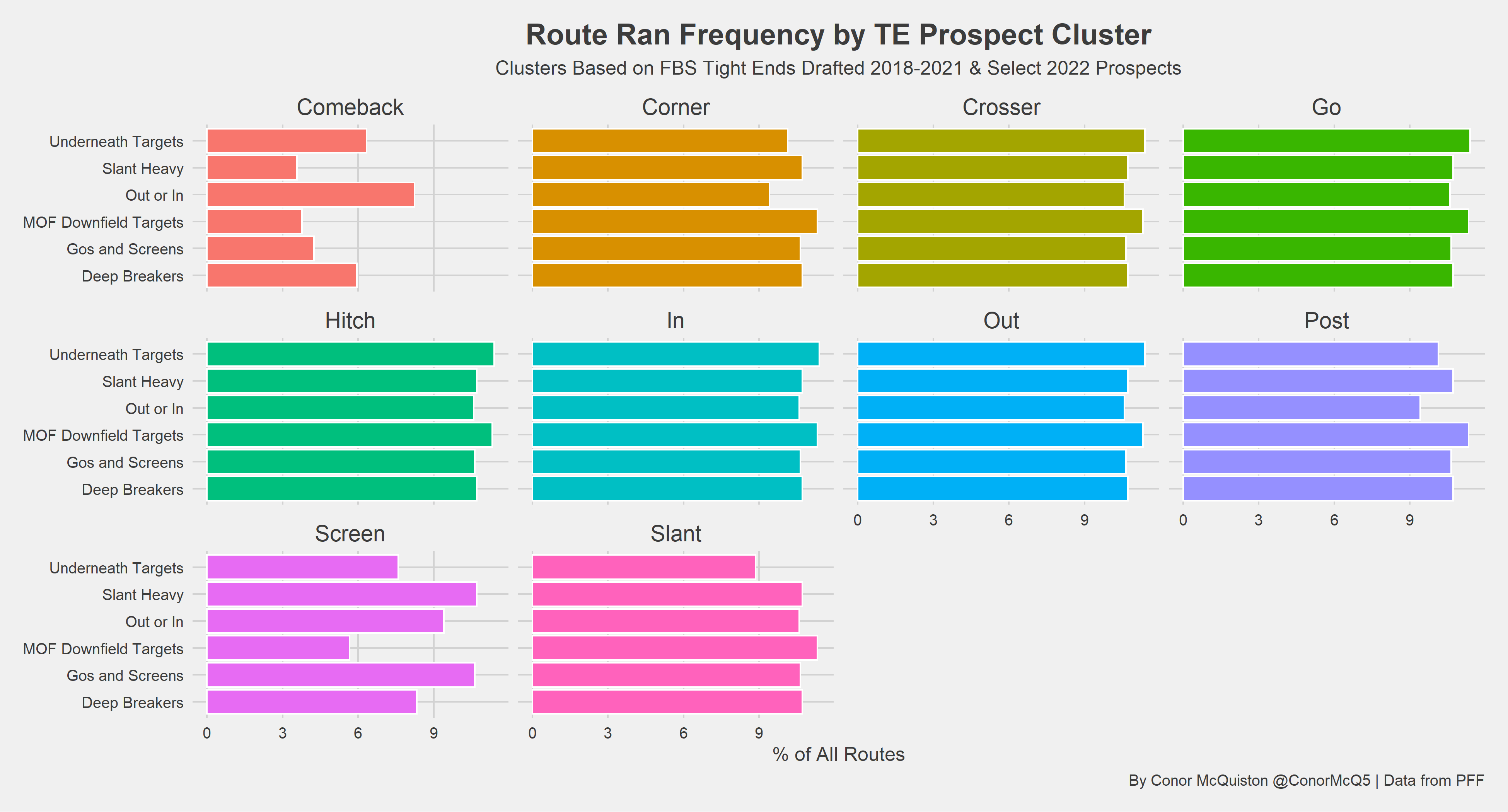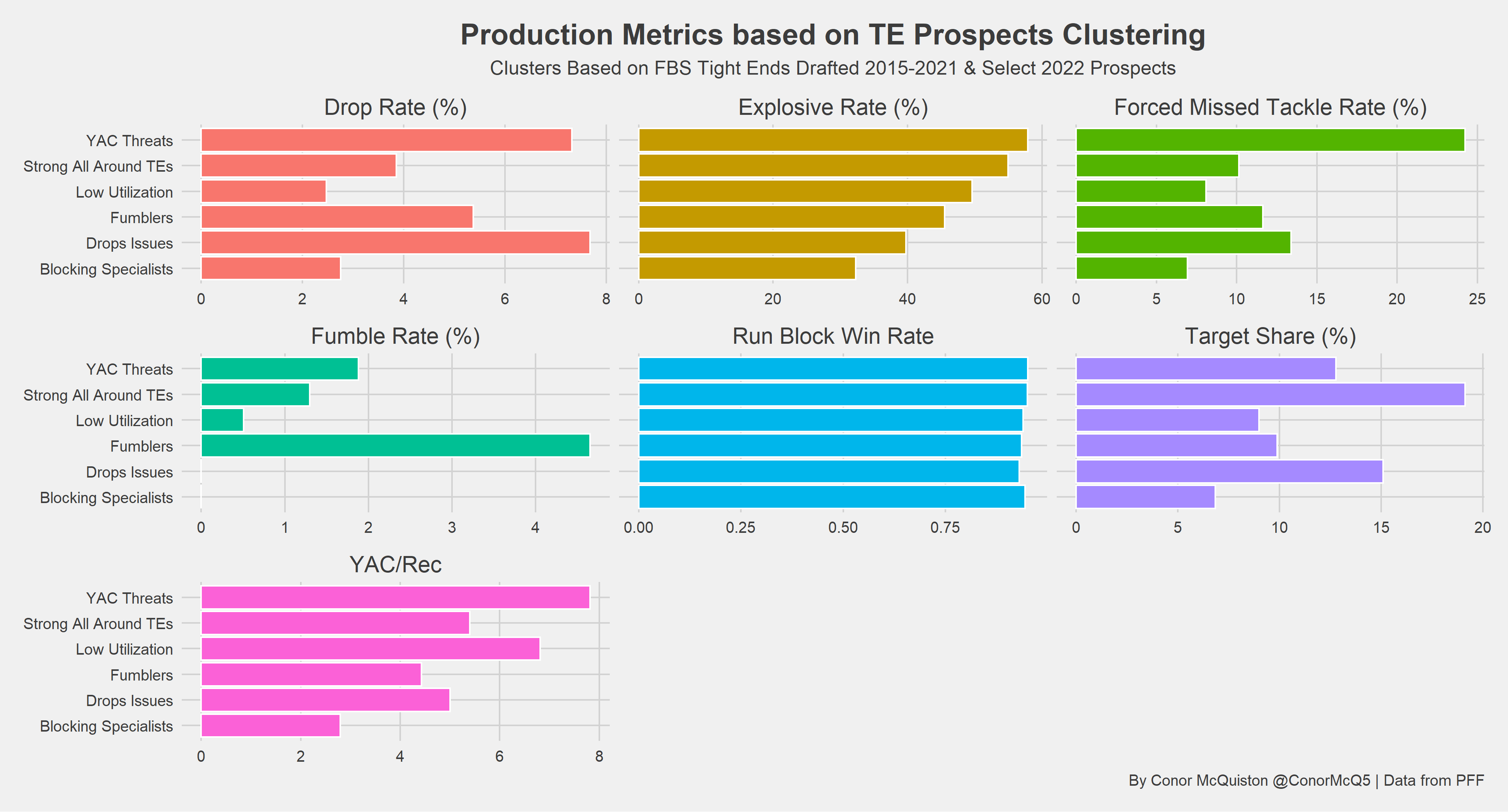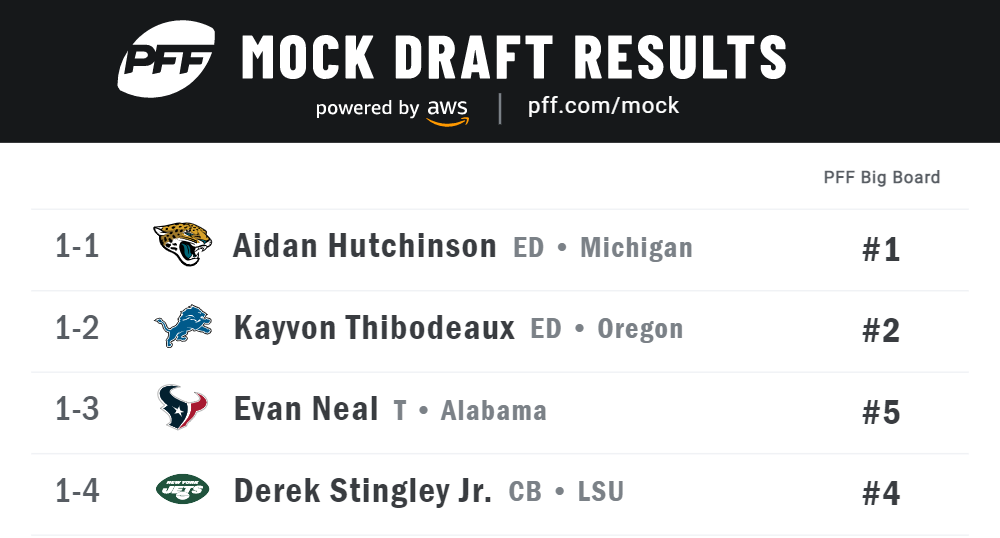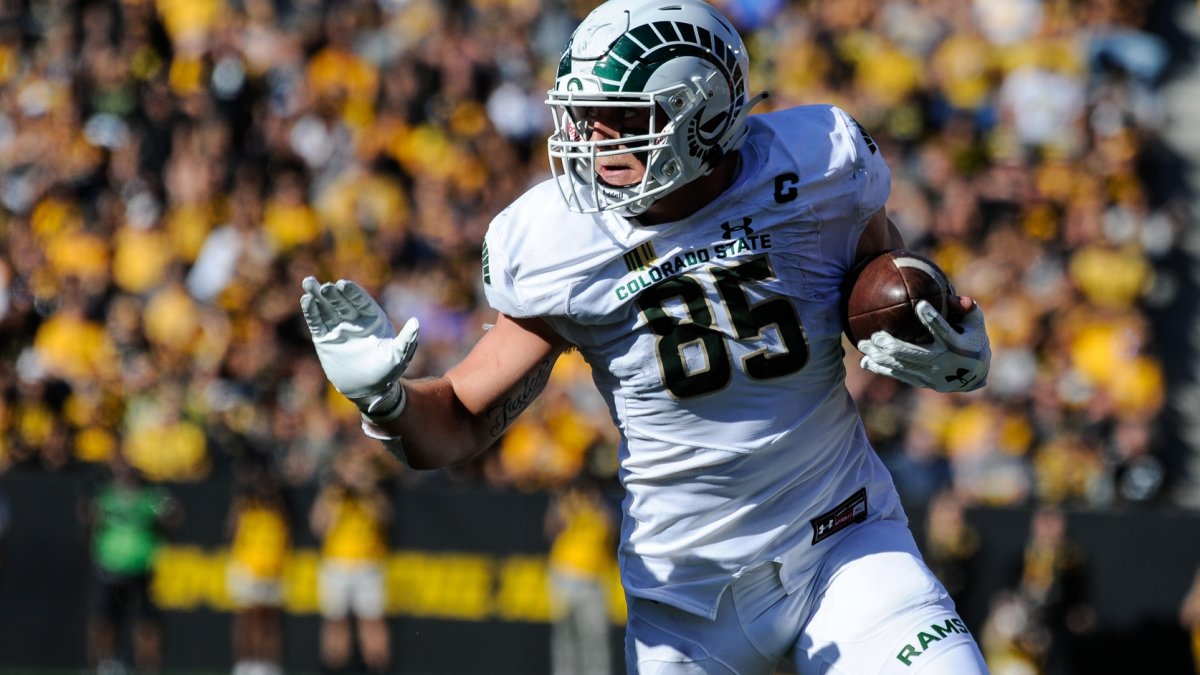Only one tight end prospect, Colorado State’s Trey McBride, currently ranks within the top 64 on PFF's big board, although five more are within the top 150 prospects. Thus, the edges this year come in attempting to find the TEs who best fit a particular offense. These prospects all come from vastly different offenses, were asked to do different things and played with quarterbacks of varying skill levels. So, how do we go about evaluating them with data?
Similar to what we’ve already done with the 2022 quarterbacks, wide receivers, defensive linemen, linebackers, defensive backs, running backs, offensive tackles and interior offensive linemen, we can do this with k-means clustering. This process allows us to group together similar players and learn about their strengths and weaknesses by comparison. For our purposes, we will be looking at the 103 FBS tight ends who have been drafted since 2015 and prospects who are likely to be drafted in 2022, then we'll try to answer two questions:
- What were the prospects asked to do?
- How did the prospects produce?
Our first question will be broken down into two subquestions: What did the offense want to do with the prospect structurally, and what routes did the player run? We’ll start with the routes question, which unfortunately reduces our sample — PFF began charting non-targeted routes for college football only in 2018. We are left with 42 tight ends, which is sizable relative to the whole sample but prevents us from comparing to older tight ends.
Click here for more PFF tools:
Rankings & Projections | WR/CB Matchup Chart | NFL & NCAA Betting Dashboards | NFL Player Props Tool | NFL & NCAA Power Rankings
Best Bets Tool
Usage Clusters

Underneath Slot Receiver TE
These players spent most of their snaps in the slot. Thus, we can reasonably assume that they run crisp routes and are mismatches for slot defenders and linebackers. The secondary feature of this group is that most of their targets come within 10 yards of the line of scrimmage, which implies they are more frequently tasked with creating after the catch. Additionally, by virtue of their alignment, they likely shoulder a smaller load in run-blocking schemes, as they rarely block first-level defenders. Thus, these players typically are slimmer, more explosive athletes who at times may resemble larger-than-average wide receivers.
San José State Spartan Josh Oliver was an example of an underneath slot receiver tight end.
Underneath In-Line TE
As the name would suggest, these players tend to be attached to the line of scrimmage with their hands in the dirt, and they mostly get targeted near the line of scrimmage. Therefore, they have more responsibilities against first-level defenders in the run game and are more frequently asked to provide support in pass protection. As such, these players are generally bigger and stronger than their slot receiver variants. In the passing game, they are still expected to be competent route runners, but getting targeted near the line of scrimmage doesn’t necessarily imply they are expected to create after the catch. Sometimes that's the case, but some of these players could also be targeted only on check downs. Which bucket the player falls into can only be determined via film study.
Alabama Crimson Tide O.J. Howard was an example of an underneath in-line tight end.
Slot Receiver TE
The broad strokes of what applies to Underneath Slot Receivers also apply to Slot Receivers. They are generally leaner since they are expected to run crisp routes and contribute more to the passing game over being forces against first-level defenders as blockers. The main difference is that they are targeted more often down the field as opposed to near the line of scrimmage. This implies that they were expected to win before or during the catch using route running or physicality — not as much after the catch.
Miami Hurricane Clive Walford was an example of a slot receiver tight end.
In-Line TE
Blocking-wise, In-Line TEs and Underneath In-Line TEs are more or less tasked with the same role of matching up against first-level defenders and occasional support in pass protection. The main difference is that in-line tight ends were targeted down the field more often. That likely means they were expected to be more involved in the passing game and not just be outlet passes/check downs. Since offenses that heavily feature in-line tight ends do not often design underneath passes to them, we can expect these players who are targeted downfield to generally be superior athletes.
Penn State Nittany Lion Jesse James was an example of an in-line tight end.
H-Back TE
These players are where you find your fullback/tight end hybrids. They’ll often have shorter, stockier builds since they are expected to lead block with a running start against first- and second-level defenders. As a result of the players' alignment, most of their targets come on screens or on passes near the line of scrimmage, and most of their passing game production comes after the catch.
North Carolina State's Jaylen Samuels was an example of an H-back tight end.

Chain-Mover TE
There is a significant amount of overlap between Chain-Movers and In-Line TEs. Since they mostly line up in-line or as a wing, they share similar blocking responsibilities to the two prior in-line groups. The differentiating factor between these three clusters is that chain-movers are more frequently targeted in an intermediate range, between 6-19 yards. This roughly corresponds to how far the first-down marker is from the line of scrimmage on most passes, implying these tight ends are primarily targeted at or near the sticks. From here, we can gather that these players are expected to win before or during the catch in the passing game, either through physicality or separation.
Minnesota Golden Gopher Maxx Williams was an example of a chain-mover tight end.
Big Receiver TE
These players spent a majority of their snaps out wide aligned as the No. 1 receiver or within the slot. They rarely lined up attached to the line of scrimmage, which functionally means they were expected to be wide receivers in most of their games. Thus, these athletes tend to be slimmer and more explosive with crisper routes but lack the reps to be consistent blockers, at least during their rookie NFL season.
Mississippi State Bulldog Jordan Thomas was an example of a big receiver tight end.
Route Clusters

Slant-Heavy TE
As the name would suggest, these players were defined by their high frequency of slant routes, and this also correlated with a high number of screens and crossers. These players ran most other routes at an average rate relative to the other groups. The predominance of slants, crossers and screens within their route tree, however, suggests these players were expected to be dangerous after the catch, and they were thus given ample opportunities to do so.
Florida Gator Kyle Pitts ran a slant-heavy route tree.
Underneath Target TE
There is a significant amount of overlap between Underneath Target and Slant-Heavy players. Namely, each group tended to run shorter routes. Underneath target tight ends were saturated with crossers, hitches, ins and outs, which could suggest these players were similarly expected to excel after the catch and given the chance to do so. Alternatively, these routes are consistent with the routes of checkdowns on many plays and thus can be a result of the players not being primary options on passes. Film study is the only way to delineate between the two.
Penn State Nittany Lion Pat Freiermuth ran an underneath target route tree.
Out/In TE
If route depth were incorporated into this dataset, then this cluster would likely either be grouped with the earlier Underneath Targets or the still-to-come MOF Downfield Targets. The notable feature of this group is that most of their routes are either outs or crossing routes. Depending on the depth of these routes, this could either make them similar to underneath target tight ends where their goal is to either be a checkdown option or create after the catch. Or they could be similar to MOF downfield target tight ends, where the goal is to find seams in zones.
Boston College Eagle Hunter Long was an example of a tight end who ran an out or in route tree.
Go and Screen TE
Relative to the groups, Go and Screen TEs are the most stratified group. An outsized portion of their routes was categorized as screen or go routes, as their name would suggest. We can assume coaching staffs expected these players to either win big down the field, likely at the catch point, or create after the catch in screens. From here we can take the small logical leap that these players are likely to be explosive athletes who lack refinement when running routes.
Miami Hurricane Brevin Jordan ran a go and screen route tree.
2022 NFL Draft position rankings:
Top 10 players at every position
QB | RB | WR | TE | iOL | OT | DI | EDGE | LB | CB | S
Middle-of-Field Downfield Target TE
As hinted earlier, MOF Downfield Target TEs have a single goal: to find the soft spot in zones. Whether that is a go route in a seam, a post route against a two-high shell or an in-route against a Cover 3 look, the players in this group are running routes on the prowl for open space. This implies that coaching staffs are expecting them to generate big plays by being naturally open as a product of the defensive coverage. The players require at least some level of athleticism to exploit these gaps.
Stanford Cardinal Colby Parkinson ran a MOF downfield target route tree.
Deep Breaker TE
In the end, Deep Breaker TEs largely have the same effect as MOF Downfield Target Tes. They run routes that are meant to exploit gaps in coverage, except with corners, deep crossers and posts. What can be said of middle-of-field downfield target tight ends can also be said of deep breaker tight ends, just with the added caveat that this appears to be how Notre Dame — in the Tommy Rees era, specifically — likes to use its tight ends.
Notre Dame's Cole Kmet was an example of a tight end who ran a deep breaker route tree.
Production Clusters

YAC Threat TE
Unsurprisingly, these players are the best after the catch of any group. They generate more missed tackles, average the most yards after the catch and boast the highest explosive reception rate. The cluster tends to have subpar hands and fumbles more often, but this is tolerated as a result of the upside the after-the-catch ability brings. These players tend to be the most athletic and explosive of any group.
Miami Hurricane David Njoku was an example of a YAC threat tight end.
Strong All-Around TE
These players were heavily featured within their offenses and were relied on to produce. They were nearly as explosive as YAC Threats but did not force as many missed tackles, nor did they average as many yards after catch despite being above average in both statistics. This would imply that, while being strong after the catch, they do not reach the same heights as their YAC Threat counterparts. Instead, they rely more on winning at the catch point, signaling they are good, not great athletes. Their run-block win rate is not notably better or worse than any other group, but these players are thought of as better blockers.
Iowa Hawkeye T.J. Hockensen was an example of a strong all-around tight end.
Low-Utilization TE
The primary feature of this group is that they were not targeted very often relative to other players on their own team. In the raw production metrics, they were largely lesser versions of Strong All-Around TEs. They were more explosive than average and forced an average number of missed tackles, but both fall behind the aforementioned group. They did generate plenty of yards after the catch and rarely dropped or fumbled the ball. This indicates these players are generally high-level athletes and at least competent blockers, but the reasons they went untargeted is worth investigating via film study.
Ole Miss Rebel Dawson Knox produced like a low-utilization tight end.
Fumbler TE
In a shocking outcome, Fumblers don’t just tend to fumble quite often, but they also tend to drop the ball. FBS tight ends tend to not get too many touches, so one flukey fumble can undeservingly place a player in this group, making it difficult to come to sweeping conclusions about them. We can say that these players tend to force an above-average number of missed tackles, implying a level of explosion and athleticism to make tolerating the fumbles worthwhile. Unfortunately, film study would serve as the best tool to fully evaluate this group.
Iowa Hawkeye George Kittle was an example of a fumbler tight end.
Drops Issue TE
Much of what can be said for Fumblers also applies to Drops Issue TEs. Drops are a more frequent occurrence, however, and thus it is more difficult to be undeserving of this group. That being said, the individual skill sets of these players are still immensely varied and difficult to make sweeping generalizations about. One thing tying them together is their barely above-average forced missed tackle rate, but since multiple different kinds of players can struggle with drops, it is not a straightforward statement. Once again, film study is necessary to determine players' strengths and weaknesses in this cluster.
Stanford Cardinal Austin Hooper was an example of a tight end with a drops issue.
Blocking Specialist TE
These players simply were not given an adequate number of touches to properly evaluate them. When they did get the ball, their touches were not particularly efficient or explosive, nor did they force many missed tackles. This suggests either they are individually unsuccessful with the ball in their hands or their touches were saturated with low efficiency plays, such as checkdowns. They were effective blockers, though, evidenced by their leading run-block win rate. Athletic testing should be able to bear out whether these players are able to expand to a more pass-centric role.
Former Auburn Tiger C.J. Uzomah was an example of a blocking specialist tight end.

Here is how the top 2022 tight end prospects stack up:
| Name | Usage Cluster | Route Cluster | Production Cluster |
| Jalen Wydermeyer | Chain-Mover | MOF Downfield Targets | Drops Issue |
| Trey McBride | Underneath In-Line TE | Out/In | Strong All-Around TE |
| Jeremy Ruckert | Chain-Mover | Underneath Targets | Fumbler |
| Cade Otton | Underneath In-Line TE | Out/In | Fumbler |
| Derrick Deese Jr. | Chain-Mover | Deep Breaker | Strong All-Around TE |
| Cole Turner | Slot Receiver | Go and Screen | Strong All-Around TE |
| Charlie Kolar | Slot Receiver | Out/In | Strong All-Around TE |
| Jake Ferguson | Underneath In-Line TE | Underneath Targets | Drops Issue |
| Jelani Woods | In-Line TE | MOF Downfield Targets | YAC Threat |
[/am4show]



 © 2025 PFF - all rights reserved.
© 2025 PFF - all rights reserved.